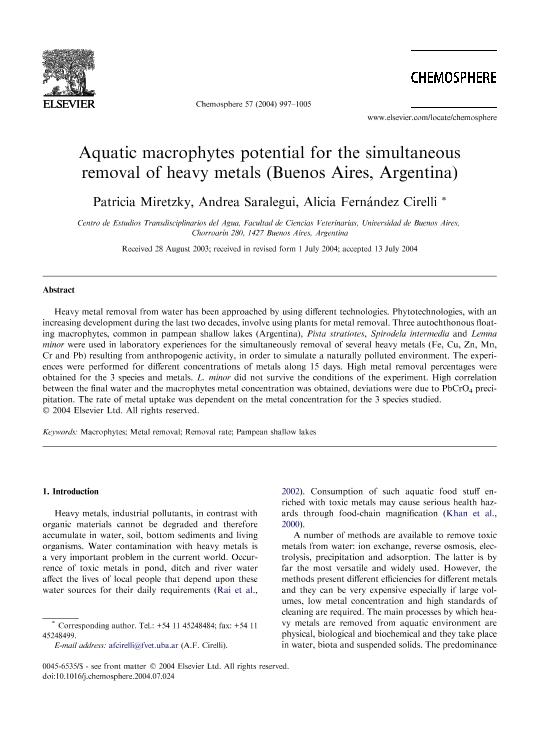Artículo
Aquatic macrophytes potential for the simultaneous removal of heavy metals (Buenos Aires, Argentina)
Fecha de publicación:
11/2004
Editorial:
Pergamon-Elsevier Science Ltd
Revista:
Chemosphere
ISSN:
0045-6535
Idioma:
Inglés
Tipo de recurso:
Artículo publicado
Clasificación temática:
Resumen
Heavy metal removal from water has been approached by using different technologies. Phytotechnologies, with an increasing development during the last two decades, involve using plants for metal removal. Three autochthonous floating macrophytes, common in pampean shallow lakes (Argentina), Pista stratiotes, Spirodela intermedia and Lemna minor were used in laboratory experiences for the simultaneously removal of several heavy metals (Fe, Cu, Zn, Mn, Cr and Pb) resulting from anthropogenic activity, in order to simulate a naturally polluted environment. The experiences were performed for different concentrations of metals along 15 days. High metal removal percentages were obtained for the 3 species and metals. L. minor did not survive the conditions of the experiment. High correlation between the final water and the macrophytes metal concentration was obtained, deviations were due to PbCrO 4 precipitation. The rate of metal uptake was dependent on the metal concentration for the 3 species studied.
Palabras clave:
MACROPHYTES
,
METAL REMOVAL
,
PAMPEAN SHALLOW LAKES
,
REMOVAL RATE
Archivos asociados
Licencia
Identificadores
Colecciones
Articulos(OCA PQUE. CENTENARIO)
Articulos de OFICINA DE COORDINACION ADMINISTRATIVA PQUE. CENTENARIO
Articulos de OFICINA DE COORDINACION ADMINISTRATIVA PQUE. CENTENARIO
Citación
Miretzky, Patricia; Saralegui, Andrea Beatriz; Fernandez Cirelli, Alicia; Aquatic macrophytes potential for the simultaneous removal of heavy metals (Buenos Aires, Argentina); Pergamon-Elsevier Science Ltd; Chemosphere; 57; 8; 11-2004; 997-1005
Compartir
Altmétricas




